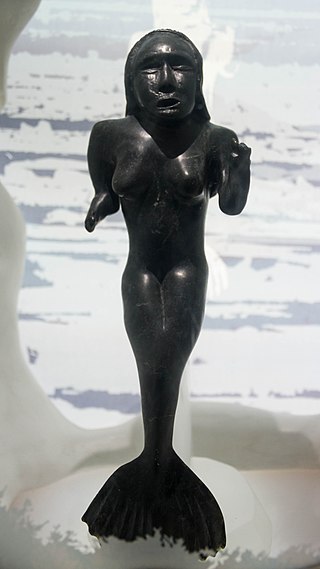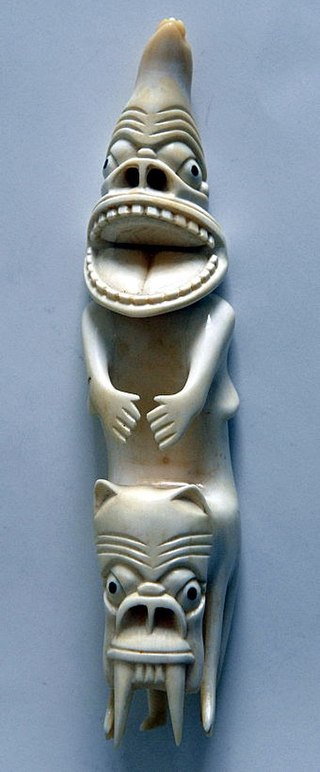
Knud Johan Victor Rasmussen was a Greenlandic–Danish polar explorer and anthropologist. He has been called the "father of Eskimology" and was the first European to cross the Northwest Passage via dog sled. He remains well known in Greenland, Denmark and among Canadian Inuit.

Inuit religion is the shared spiritual beliefs and practices of the Inuit, an indigenous people from Alaska, northern Canada, parts of Siberia and Greenland. Their religion shares many similarities with some Alaska Native religions. Traditional Inuit religious practices include animism and shamanism, in which spiritual healers mediate with spirits. Today many Inuit follow Christianity, but traditional Inuit spirituality continues as part of a living, oral tradition and part of contemporary Inuit society. Inuit who balance indigenous and Christian theology practice religious syncretism.

The Sun and the Moon is an unipkaaqtuat, a story in Inuit folklore. The traditional explanation for the movement of the Sun and Moon through the sky is a brother and sister are constantly chasing each other across the sky. The story also explains the dappled gray appearance of the moon as soot smeared on his face.
In Inuit religion, Nerrivik or Nerivik was the sea-mother and provider of food for Inuit. She was the patron of fisherman and hunters. In Canada, she was known as either Sedna or Arnapkapfaaluk and in Greenland, she was Arnakuagsak.

Igloolik is an Inuit hamlet in Foxe Basin, Qikiqtaaluk Region in Nunavut, northern Canada. Because its location on Igloolik Island is close to Melville Peninsula, it is often mistakenly thought to be on the peninsula. The name "Igloolik" means "there is a house here". It derives from iglu meaning house or building, and refers to the sod houses that were originally in the area, not to snow igloos. In Inuktitut the residents are called Iglulingmiut.
In Inuit religion, A'akuluujjusi is considered the great creator mother, a primordial goddess, by Inuit.
Zacharias Kunuk is a Canadian Inuk producer and director most notable for his film Atanarjuat: The Fast Runner, the first Canadian dramatic feature film produced entirely in Inuktitut. He is the president and co-founder with Paul Qulitalik, Paul Apak Angilirq, and the only non-Inuit, ex-New Yorker team member, Norman Cohn, of Igloolik Isuma Productions, Canada's first independent Inuit production company. Atanarjuat: The Fast Runner (2001), the first feature film that was entirely in Inuktitut was named as the greatest Canadian film of all time by the 2015 Toronto International Film Festival poll.

The Journals of Knud Rasmussen is a 2006 Canadian-Danish film directed by Zacharias Kunuk and Norman Cohn. The film is about the pressures on traditional Inuit shamanistic beliefs as documented by Knud Rasmussen during his travels across the Canadian Arctic in the 1920s.

Lorenz Peter Elfred Freuchen was a Danish explorer, author, journalist and anthropologist. He is notable for his role in Arctic exploration, namely the Thule Expeditions.

Traditional Alaskan Native religion involves mediation between people and spirits, souls, and other immortal beings. Such beliefs and practices were once widespread among Inuit, Yupik, Aleut, and Northwest Coastal Indian cultures, but today are less common. They were already in decline among many groups when the first major ethnological research was done. For example, at the end of the 19th century, Sagdloq, the last medicine man among what were then called in English, "Polar Eskimos", died; he was believed to be able to travel to the sky and under the sea, and was also known for using ventriloquism and sleight-of-hand.

The Netsilik (Netsilingmiut) are Inuit who live predominantly in Kugaaruk and Gjoa Haven of the Kitikmeot Region, Nunavut and to a smaller extent in Taloyoak and the north Qikiqtaaluk Region, in Canada. They were, in the early 20th century, among the last northern indigenous peoples to encounter missionaries from the south.

In Greenlandic Inuit religion, a tupilaq was an avenging monster fabricated by a practitioner of witchcraft or shamanism by using various objects such as animal parts and even parts taken from the corpses of children. The creature was given life by ritualistic chants. It was then placed into the sea to seek and destroy a specific enemy.

Uvavnuk was an Inuk woman born in the 19th century, now considered an oral poet. The story of how she became an angakkuq, and the song that came to her, were collected by European explorers of Arctic Canada in the early 1920s. Her shamanistic poem-song, best known as "Earth and the Great Weather", has been anthologised many times.
Orpingalik was a Netsilik Inuit angakkuq and oral poet who provided anthropological input to Danish explorer Knud Rasmussen during the latter's 1921–1924 expedition.
Madeline Piujuq Ivalu is a Canadian Inuk filmmaker and actor from Igloolik, Nunavut. One of the cofounders of Arnait Video Productions, a women's video and filmmaking collective in Nunavut, she co-directed, co-wrote and starred in Arnait's first feature film production, Before Tomorrow . She costarred in the film with her real-life grandson, Paul-Dylan Ivalu. Her codirector of the film was Marie-Hélène Cousineau, and both women cowrote the film with Susan Avingaq.

Arnarulunnguaq (1896–1933), a native Greenlander, was a key member of Knud Rasmussen's Fifth Thule Expedition (1921–1924) which crossed the Northwest Passage by dog sled. She was one of the two who accompanied Rasmussen from the Hudson Bay to Alaska, preparing meals and keeping skins and furs in order throughout the two-year journey. As a result, she was the first woman to complete the long Arctic journey from Greenland to the Pacific.
Idlirvirissong, or Irdlirvirisissong, is an evil spirit in the religion of the Inuit of Baffin Island and the Greenlandic Inuit.











